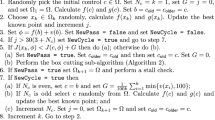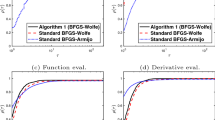Abstract
A new method for continuous global minimization problems, acronymed SCM, is introduced. This method gives a simple transformation to convert the objective function to an auxiliary function with gradually ‘fewer’ local minimizers. All Local minimizers except a prefixed one of the auxiliary function are in the region where the function value of the objective function is lower than its current minimal value. Based on this method, an algorithm is designed which uses a local optimization method to minimize the auxiliary function to find a local minimizer at which the value of the objective function is lower than its current minimal value. The algorithm converges asymptotically with probability one to a global minimizer of the objective function. Numerical experiments on a set of standard test problems with several problems' dimensions up to 50 show that the algorithm is very efficient compared with other global optimization methods.
Similar content being viewed by others
References
Cetin, B.C., Barhne, J. and Burdick, J.W. (1993), Terminal Repeller unconstrained subenergy tunneling (TRUST) for fast global optimization, Journal of Optimization Theory and Applications 77(1), 97-126.
Coleman, T., Shalloway, D. and Wu, Z. (1992), Isotropic effective energy simulated annealing searches for low energy molecular cluster states, Technical Report CTC-92-TR113, Center for Theory and Simulation in Science and Engineering, Cornell University.
Coleman, T., Shalloway, D. and Wu, Z. (1993), A parallel build-up algorithm for global energy minimizations of molecular clusters using effective energy simulated annealing, Technical Report CTC-93-TR130, Center for Theory and Simulation in Science and Engineering, Cornell University.
Coleman, T. and Wu, Z. (1994), Parallel continuation-based global optimization for molecular conformation and protein folding, Technical Report CTC-94-TR175, Center for Theory and Simulation in Science and Engineering, Cornell University.
Ge, R.P. (1990), A filled function method for finding a global minimizer of a function of several variables, Mathematical Programming 46, 191-204.
Ge, R.P. and Qin Y.F. (1990), The globally convexized filled functions for global optimization, Applied Mathematics and Computation 33, 131-158.
Kostrowicki, J. and Piela, L. (1991), Diffusion equation method of global minimization: performance for standard test functions, Journal of Optimization Theory and Applications 69(2), 97-126.
Kostrowicki, J., Piela, L., Cherayil B.J. and Scheraga A. (1991), A performance of the diffusion equation method in searches for optimum structures of clusters of Lennard-Jones atoms, Journal of Physical Chemistry 95, 4113-4119.
Levy, A.V. and Montalvo, A. (1985), The tunneling algorithm for the global minimization of functions, SIAM Journal on Scientific and Statistical Computing 6, 15-29.
Rinnooy Kan, A.H.G. and Timmer, G.T. (1987), Stochastic global optimization methods, Part I: Clustering methods, Mathematical Programming 39, 27-56.
Rinnooy Kan, A.H.G. and Timmer, G.T. (1987), Stochastic global optimization methods, Part II: Multi-level methods, Mathematical Programming 39, 57-78.
Shalloway, D. (1991), Packet annealing: a deterministic method for global minimization with applications to molecular conformation, Preprint, Section of Biochemistry, Molecular and Cell Biology, Global Optimization, C. Floudas and P. Pardalos (eds.), Princeton University Press, Princeton, NJ.
Wu, Z. (1993), The effective energy transformation scheme as a special continuation approach to global optimization with application to molecular conformation, Technical Report CTC-93-TR143, Center for Theory and Simulation in Science and Engineering, Cornell University, 1993.
Author information
Authors and Affiliations
Rights and permissions
About this article
Cite this article
Zhu, W., Fu, Q. A Sequential Convexification Method (SCM) for Continuous Global Optimization. Journal of Global Optimization 26, 167–182 (2003). https://doi.org/10.1023/A:1023031513471
Issue Date:
DOI: https://doi.org/10.1023/A:1023031513471




